


A newsletter for modern marketers.

TRUSTED BY THE WORLD'S SMARTEST MARKETERS
Free ad performance benchmarks every week.

Live webinars and strategy sessions with industry leaders.
Watch all previous episodes on our YouTube channel.
Insider strategies from the smartest brands in ecommerce.
SEE LATEST POSTS:
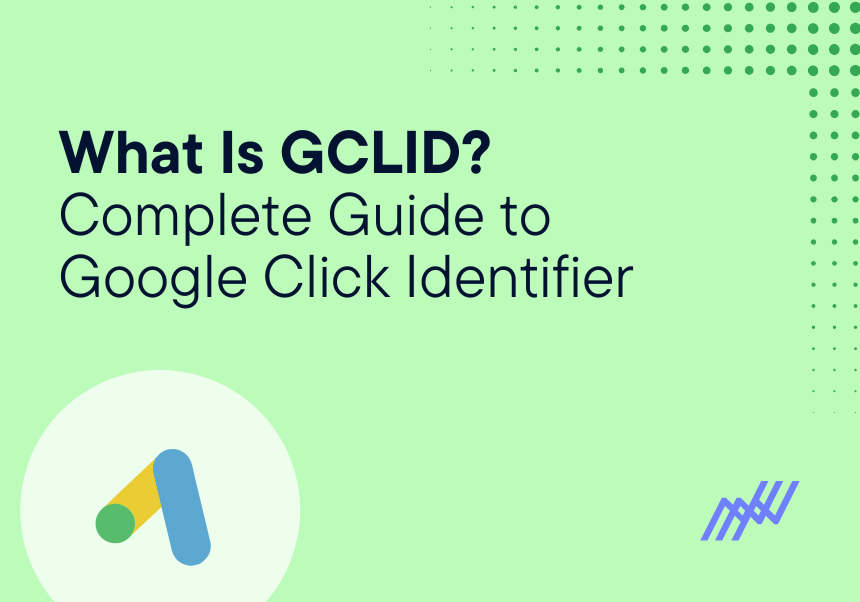
What Is GCLID? Complete Guide to Google Click Identifier

Have you ever clicked on a Google Ad and noticed a “?gclid=” string in the URL?
This little snippet of code is one of the most important keys to understanding your Google Ad performance.
The Google Click Identifier (GCLID) is how Google connects the dots between an ad click and a conversion.
Without it, you can’t reliably tie a purchase, form submission, or sign-up back to the exact campaign, keyword, and creative that drove it. It’s what makes Google Ads’ reporting and optimization features accurate.
Here’s how GCLID works:
- Every time someone clicks on your Google Ad, a unique GCLID is added to the landing page URL.
- That GCLID tells Google which ad was clicked, when, and under what targeting conditions.
- When the person converts, that same GCLID lets Google attribute the result to the right ad spend.
- Combined with UTMs, GCLIDs give you both precise Google Ads tracking and a full multi-channel view of performance.
Understanding how GCLID works, and how to make sure you’re capturing it correctly, means more accurate attribution, smarter budget allocation, and a clear picture of ROI.
What Is GCLID?

GCLID stands for Google Click Identifier, a unique tracking parameter that Google Ads automatically adds to your landing page URLs whenever someone clicks on your ad.
A GCLID might look something like this:
https://www.example.com?gclid=XYZ123
This seemingly random string is actually a powerful tracking tool.
Each GCLID is unique to a specific ad click and contains encoded information about the campaign, ad group, keyword, and other targeting details.
The purpose of a GCLID is simple but essential:
- Link each ad click to its source so you can see which campaigns and keywords drive conversions.
- Track performance across the customer journey, from the initial click to the final purchase or lead submission.
- Enable more accurate attribution, helping you understand exactly where your ad spend is delivering the best return.
Because the GCLID is automatically generated and appended by Google Ads, there’s no manual setup required, but you do need to ensure your tracking systems capture and retain it for it to work effectively.
GCLID vs UTMs: How They Work Together
Marketers often confuse GCLID parameters with UTM tags, but they serve different, and complementary, purposes.
GCLID is automatic and generated by Google Ads when GCLID auto-tagging is enabled. It’s used primarily for Google Ads conversion tracking and reporting.
UTM parameters, on the other hand, are manual tags that you add to URLs yourself (or via a campaign builder tool).
UTMs are platform-agnostic and used for cross-channel tracking in analytics tools like Google Analytics, HubSpot, or Northbeam.
The table below highlights GCLID vs UTM:
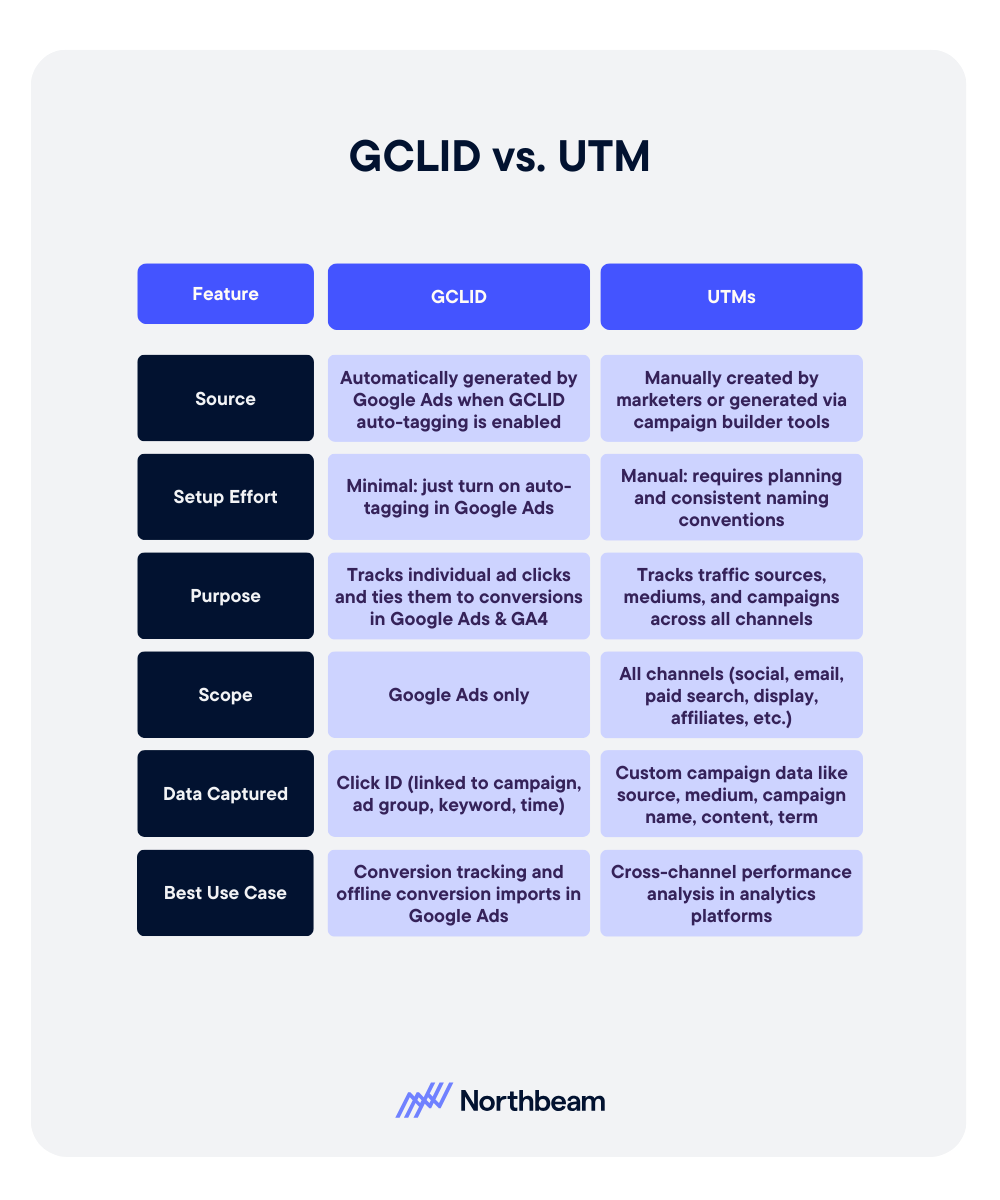
When combined, GCLID gives you the click-level precision Google Ads needs, while UTMs provide the big-picture view across every marketing channel.
How Does GCLID Work?
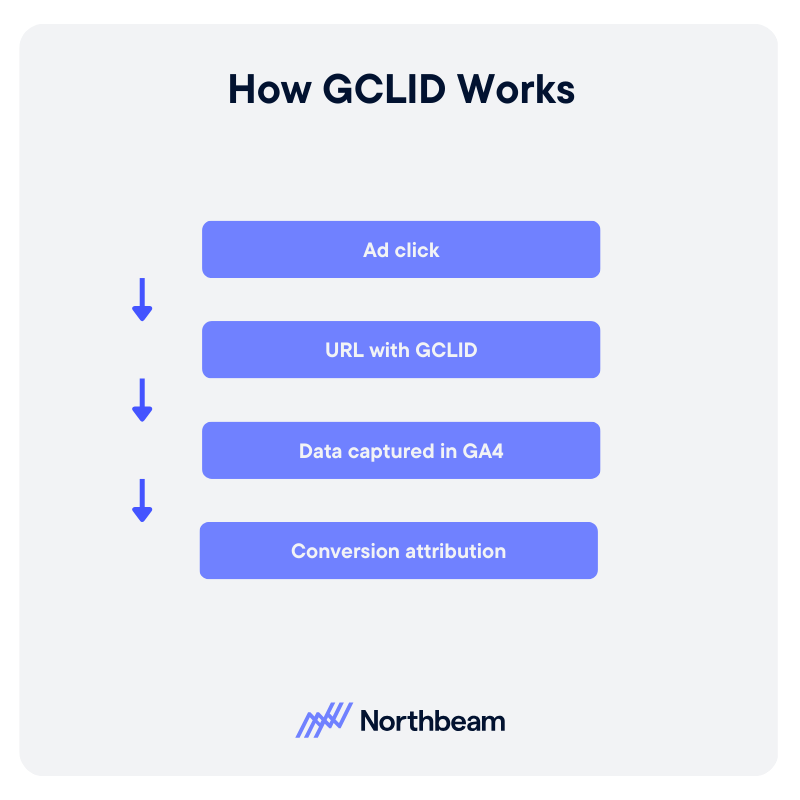
GCLID works behind the scenes to connect ad clicks with conversion data, and it does this in just a few quick steps:
- A user clicks your Google Ad. When someone clicks on your ad, Google automatically generates a unique Google Click Identifier tied to that specific click.
- Google appends the GCLID to your landing page URL. The click sends the user to your destination URL with the GCLID parameter attached.
- Your analytics tools capture the GCLID. Google Ads and Google Analytics 4 (GA4) read the GCLID and use it to connect the click to details like the campaign, ad group, keyword, and timestamp.
- The GCLID links clicks to conversions. When a user completes a tracked action, such as filling out a form, signing up for a trial, or making a purchase, the GCLID makes it possible to attribute that conversion back to the exact ad interaction.
This process is instant and invisible to the end user, but for marketers, it’s the backbone of accurate Google Ads reporting and optimization.
Why Is GCLID Important?
GCLID isn’t just a random string in your URLs. it’s the key to making your Google Ads budget work harder. Here’s why it matters:
Conversion Tracking
Without GCLID, Google Ads can’t reliably match ad clicks to conversions.
By linking each conversion back to the specific click that drove it, you can measure the true impact of your campaigns and justify your ad spend with GCLID for conversion tracking.
Offline Conversions
Many conversions happen offline, like a phone order, in-store purchase, or signed contract.
If you capture the GCLID from the original ad click (e.g., in a CRM form), you can later upload that data into Google Ads to connect offline sales with the campaigns that generated them.
Attribution Accuracy
GCLID provides click-level data that helps you understand exactly which campaign, keyword, and creative led to a conversion. This level of detail allows you to:
- Optimize bidding strategies
- Pause underperforming ads
- Double down on high-ROI campaigns
In short, if you’re not tracking GCLID, you’re flying blind on where your ad dollars are actually paying off.
How to Enable and Track GCLID
Setting up GCLID tracking takes just a few steps, and once it’s in place, you’ll have a stronger foundation for measuring and improving your Google Ads performance.
Enable Auto-Tagging in Google Ads
Auto-tagging automatically appends the GCLID parameter to your ad URLs.
To turn it on:
- Sign in to your Google Ads account.
- Click the Admin (wrench icon) in the top menu and select Account Settings.
- Under Auto-tagging, check the box for “Tag the URL that people click through from my ad”.
- Click Save.
You can test this by clicking on one of your own ads and confirming the URL includes a ?gclid= parameter.
Link Google Ads with Google Analytics 4 (GA4)
Wondering how GCLID works in GA4 and Google Analytics? Linking the two tools ensures your GCLID data flows between Google Ads and Analytics for full-funnel reporting.
To link accounts:
- In Google Ads, go to Tools & Settings → Linked accounts.
- Choose Google Analytics (GA4) and select the property you want to link.
- Enable Personalized advertising and Auto-tagging override if prompted.
Capture GCLID in Your CRM for Offline Conversions
If you track leads or sales outside your website (phone calls, in-store purchases, signed contracts), capturing the GCLID lets you later upload offline conversions to Google Ads.
Best practices:
- Add a hidden form field on your lead forms to store the GCLID from the URL.
- Pass the value into your CRM or marketing automation platform.
- When a sale closes, export the GCLID and upload it to Google Ads via the Offline Conversions tool.
Use Google Tag Manager (GTM) to Grab GCLID from URLs
Google Tag Manager can capture the GCLID without extra coding.
Here are the steps:
- In GTM, create a URL Variable that pulls the gclid query parameter.
- Store this variable in a cookie or send it to your analytics platform.
- Use it for attribution and offline conversion uploads.
With these steps in place, every ad click, whether it converts online or offline, can be accurately tracked and attributed back to the campaign that drove it.
Common Issues with GCLID and How to Fix Them
Even if you’ve enabled auto-tagging, GCLID tracking can break without you realizing it, leading to incomplete or inaccurate data.
Here are the most common issues and how to resolve them.
Lost GCLID During Redirects
Issue: When your landing page URL redirects (for example, from http:// to https://, or via geo-redirects), the GCLID parameter can be stripped from the URL.
Fix:
- Ensure all redirects pass query parameters to the final destination URL.
- Update your server or CMS settings to preserve parameters during redirects.
Auto-Tagging Not Enabled in Google Ads
Issue: Without auto-tagging, GCLIDs will never be appended to your URLs in the first place.
Fix:
- In Google Ads, go to Account Settings → Auto-tagging and check “Tag the URL that people click through from my ad”.
- Test by clicking on a live ad and confirming the GCLID appears in the address bar.
Tracking Discrepancies Between Google Ads and Analytics
Issue: You see conversions in Google Ads that aren’t reflected in Google Analytics, or vice versa.
Fix:
- Confirm your Google Ads and GA4 accounts are linked.
- Check that your GCLID in Google Analytics property is set to collect Google Signals data.
- Ensure time zones and attribution settings align between platforms.
Troubleshooting Checklist
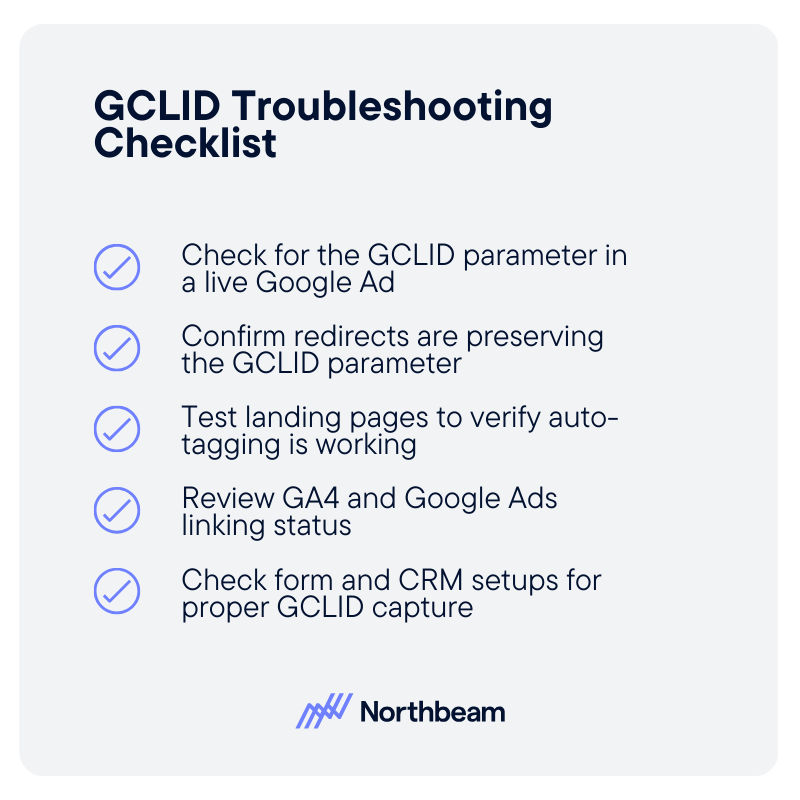
Use this quick checklist to identify and fix GCLID tracking issues:
- Click on a live Google Ad and check for ?gclid= in the URL.
- Confirm redirects are preserving query parameters.
- Test landing pages in Google Tag Assistant to verify GCLID auto-tagging is working.
- Review the linking status of GCLID in Google Analytics and Google Ads.
- Check form and CRM setups for proper GCLID capture.
Best Practices for GCLID Tracking
To get the most value from GCLID data, and ensure you never lose critical conversion insights, follow these best practices:
Always Enable Auto-Tagging in Google Ads
Auto-tagging is the easiest way to ensure GCLIDs are appended to your URLs. Without it, you’ll lose click-level tracking in Google Ads.
Test Ad URLs Regularly
Periodically click on your live ads to confirm the ?gclid= parameter appears in the address bar. This helps catch broken tracking before it impacts reporting.
Capture GCLID in Your Backend Systems
Add a hidden form field to your lead capture forms to store the GCLID from the landing page URL. Pass this value into your CRM so it’s available for offline conversion uploads.
Combine GCLID Data with UTM Parameters
GCLID provides precise Google Ads tracking, while UTMs give you a cross-channel view. Using both ensures you can attribute conversions across your full marketing mix.
Preserve GCLID During Redirects
If your site uses redirects, make sure query parameters are passed along to the final landing page so you don’t lose tracking data.
With these best practices in place, you’ll have a reliable, consistent flow of data, giving you confidence in your ROI calculations and campaign optimizations.
The Bottom Line on GCLID
The Google Click Identifier (GCLID) may be just a small snippet in your URL, but it’s a big deal for marketers who want accurate, actionable insights from their Google Ads campaigns.
By capturing and preserving GCLIDs, you can:
- Confidently link ad spend to conversions
- Track offline sales alongside online actions
- Gain click-level attribution for smarter optimization
Whether you’re running small campaigns or managing a large ad budget, getting GCLID tracking right is essential for measuring ROI and making data-driven decisions.
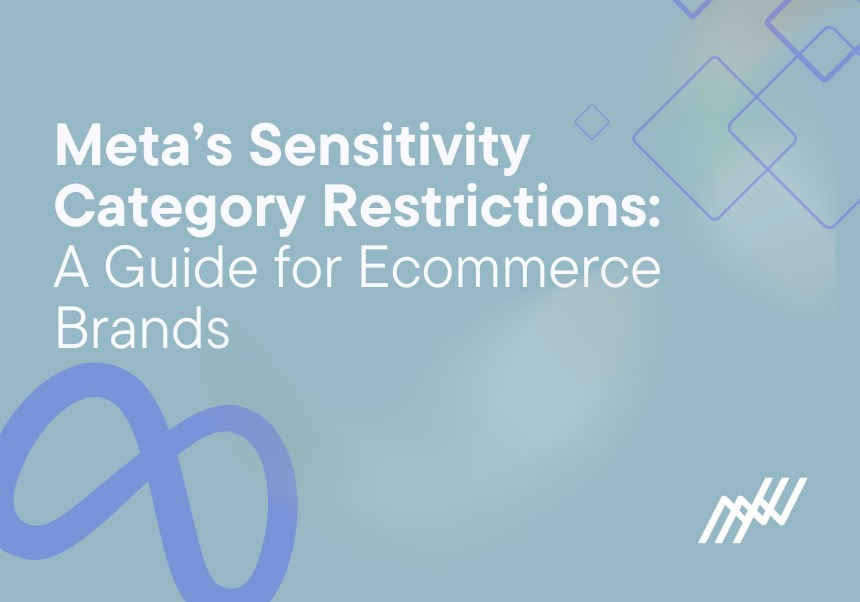
Meta’s Sensitivity Category Restrictions: A Guide for Ecommerce Brands

Meta’s sensitivity category restrictions can disrupt how marketers track and optimize their campaigns.
By assigning certain industries to “sensitive” categories, Meta now limits access to lower-funnel events and restricts how much conversion data can be shared. That means fewer optimization levers, less visibility into what’s driving sales, and more risk of wasted ad spend.
In this guide, we’ll break down what the Meta sensitivity category restrictions are, which industries are most affected, and why these changes matter for ecommerce.
More importantly, we’ll share practical strategies for adapting to these rules, and show how tools like Northbeam can help you maintain clarity and performance even when platform signals are cut off.
What Are the Meta Sensitivity Category Restrictions?
Meta has a sensitivity category system that classifies certain industries as “restricted.”
When a brand falls into one of these categories, Meta limits how much tracking and optimization data it can access through tools like the Pixel and Conversions API (CAPI).
Not all restrictions are the same.
Some categories face full restrictions, which remove the ability to optimize campaigns toward key lower-funnel events like purchases.
Others receive partial restrictions, where you can still run campaigns but may lose access to certain targeting options or event types (for example, optimizing for “Add to Cart” but not for “Purchase”).
In short, these rules change how advertisers in sensitive verticals can track, measure, and optimize performance, forcing them to adapt their strategy and measurement approach.
Which Industries Are Impacted?
Not every advertiser feels the effects of the Meta sensitivity category restrictions in the same way. The restrictions are focused on industries deemed more sensitive due to Meta’s privacy restrictions in ecommerce as well as ethical and regulatory concerns.
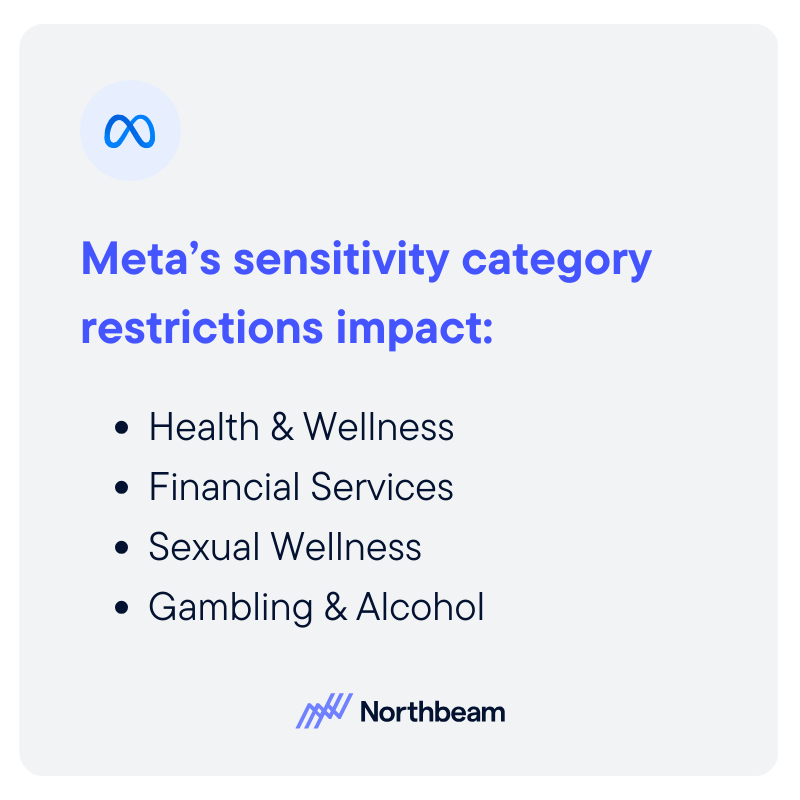
Meta’s sensitive categories include:
- Health & Wellness: especially products tied to specific conditions or treatments, which raise privacy considerations.
- Financial Services: from credit cards to investment platforms, where regulations around targeting are already strict.
- Sexual Wellness: products in this space are often flagged as sensitive content.
- Gambling and Alcohol: heavily regulated industries where ad targeting is tightly controlled.
In addition, lifestyle brands with adjacent offerings (like supplements, skincare, or certain subscription services) may find themselves flagged under Meta’s sensitive categories even if they don’t directly sell restricted products.
The challenge doesn’t stop there.
Misclassification risk is real: if Meta assigns your brand to a restricted category by mistake, you could lose access to critical optimization events, misreport campaign performance, or waste budget targeting the wrong audience.
This makes it essential for advertisers to regularly monitor their category status and act quickly if misclassified as one of Meta’s sensitive categories.
Why This Matters for Ecommerce
For ecommerce advertisers, the Meta sensitivity category restrictions aren’t just a policy change, they represent a fundamental disruption to performance visibility.
Signal Loss
When Meta restricts lower-funnel events like purchases, advertisers lose the ability to clearly attribute sales or feed back accurate data into Meta’s optimization engine.
That means the algorithm has less context to find high-value customers.
Budget Waste
With less precise targeting and optimization, brands risk spending more to reach less qualified audiences, driving up customer acquisition costs.
Inaccurate Reporting
If a campaign is misclassified, performance data may underrepresent conversions or misstate return on ad spend, making it harder to evaluate channel efficiency.
Bigger Than iOS 14?
Many advertisers compare these Meta ad restrictions in 2025 to Apple’s iOS 14 privacy updates, which cut off large portions of signal from Meta campaigns.
But sensitivity restrictions can hit even harder, removing optimization paths altogether rather than simply limiting attribution windows.
In short, the new rules could have direct bottom-line consequences if brands don’t proactively adjust how they measure and optimize campaigns.
The good news: there are clear steps brands can take to adapt, and even find new opportunities in the process.
How to Adapt Your Strategy
Meta’s sensitivity restrictions don’t have to mean a performance collapse. The key is adjusting your playbook to maintain visibility, efficiency, and control.
Here are five steps ecommerce brands can take right now:
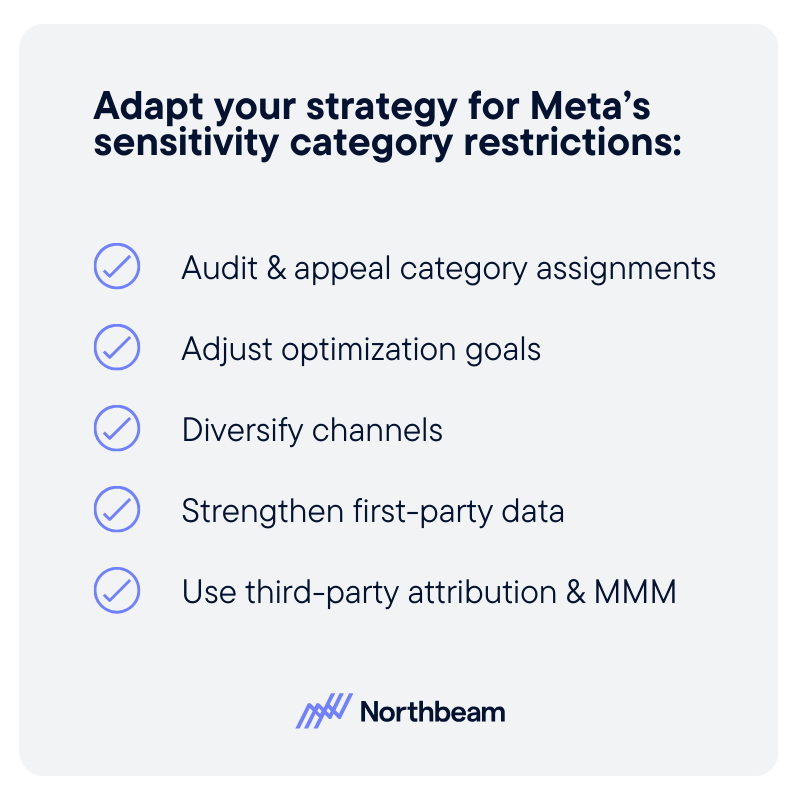
1. Audit & Appeal Category Assignments
Start by checking your account’s classification in Meta Events Manager.
If you’ve been placed into a sensitive category incorrectly, you can submit an appeal with supporting documentation.
Staying on top of this ensures you don’t lose optimization capabilities due to an error in Meta’s system.
2. Adjust Optimization Goals
If full purchase optimization is no longer available, shift to higher-funnel events like ViewContent, Landing Page Views, or Add to Cart.
While these aren’t as close to revenue, they still provide the algorithm with valuable signals to identify interested users and keep campaigns moving forward.
3. Diversify Channels
Avoid over-reliance on Meta by building a more balanced channel mix.
Consider open-web campaigns, search ads, retail media networks, or influencer partnerships.
Spreading spend across multiple platforms not only reduces risk but also helps uncover new sources of incremental growth.
4. Strengthen First-Party Data
Invest in building durable, owned audiences through email, SMS, and CRM systems.
These first-party data assets are immune to platform restrictions and can be used to power both remarketing campaigns and lookalike audiences with greater control.
5. Use Third-Party Attribution & MMM
When platform signals are restricted, third-party solutions like Northbeam provide a unified view of performance.
By combining modeled conversions, cross-channel insights, and methodologies like incrementality testing and media mix modeling (MMM), you can maintain budget efficiency and accurately measure channel lift, even without full Meta data.
Northbeam’s Role in Navigating Restrictions
When platform signals break down, analytics clarity becomes more important than ever. That’s where Northbeam comes in.
Northbeam provides advanced attribution and measurement tools designed to connect fragmented platform data into a unified, accurate view of performance.
Even when Meta limits purchase optimization or pixel events, Northbeam’s modeling capabilities allow brands to track conversions with confidence.
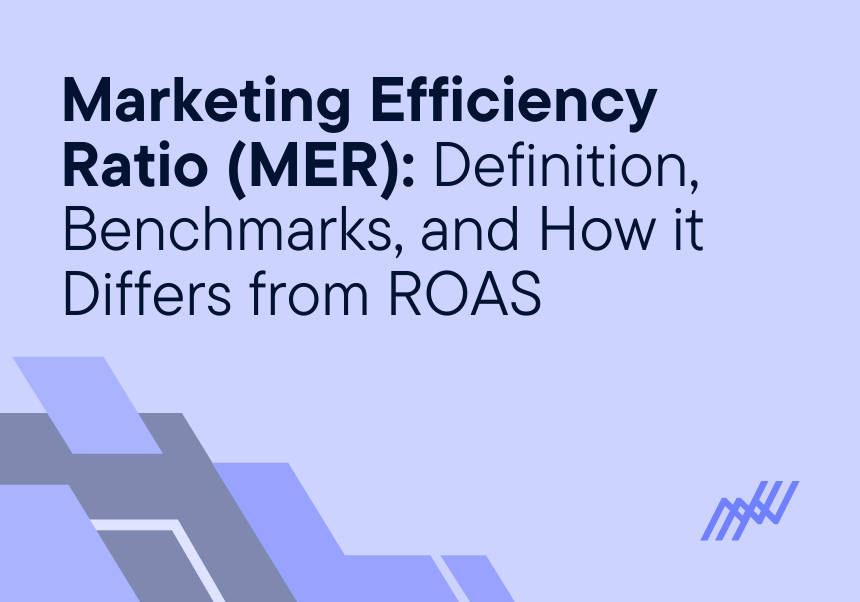
Marketing Efficiency Ratio (MER): Definition, Benchmarks, and How it Differs from ROAS

The marketing world is full of metrics, and few cause more confusion than MER and ROAS.
On the surface, they seem interchangeable. In reality, they serve different purposes, and knowing which to prioritize can mean the difference between scaling profitably and burning through budget.
As marketers juggle cash flow, growth targets, and increasingly complex customer journeys, choosing the right metric at the right time can dramatically shift outcomes.
The wrong focus can create blind spots; the right one can sharpen your strategy and unlock stronger returns.
In this guide, we’ll break down what each metric measures, how they differ, and when to use each of them.
You’ll learn how to combine MER’s big-picture view with ROAS’s tactical precision to drive both short-term wins and long-term growth.
Let’s dive in.
What Is Marketing Efficiency Ratio (MER)?
Marketing Efficiency Ratio (MER), also called Media Efficiency Ratio, measures the relationship between the total revenue your business generates and your total marketing or advertising spend.
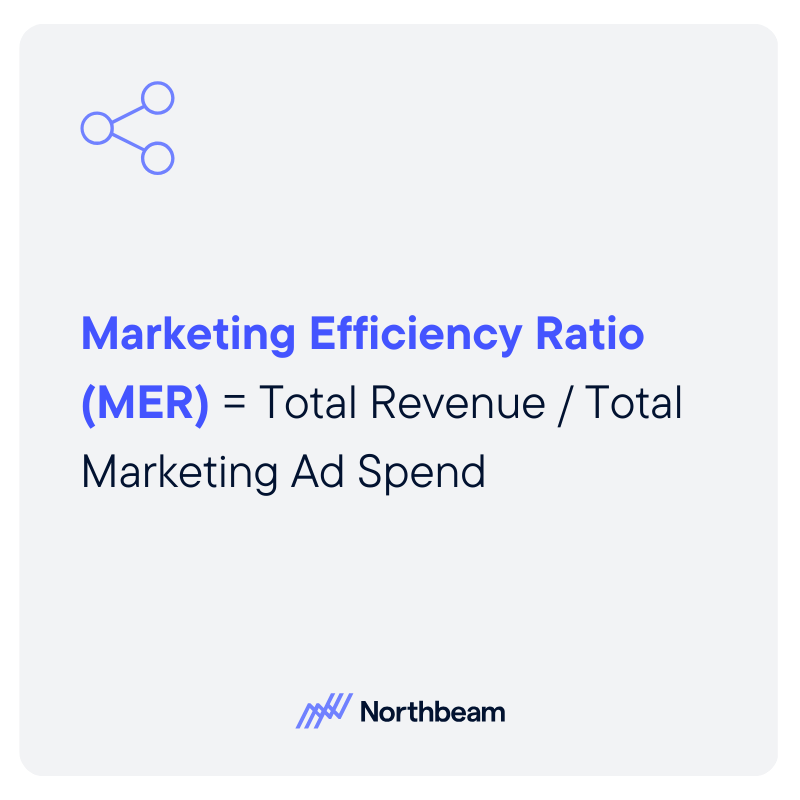
The Marketing Efficiency Ratio formula is simple: MER = Total Revenue ÷ Total Marketing/Ad Spend
Unlike campaign-level metrics, MER takes a top-down, holistic view of performance. It looks at all channels and campaigns together, showing you how efficiently your total marketing investment is converting into revenue.
This broad scope is why MER is sometimes referred to as blended ROAS or eROAS.
Instead of focusing on the return from a single campaign, it captures the cumulative effect of all your marketing activity, including brand-building efforts, halo effects from organic traffic, and cross-channel influence.
In some industries, you may also see MER framed as TACoS (Total Advertising Cost of Sale).
While the name is different, the concept is the same: understanding how much revenue you’re generating for every dollar spent across all marketing efforts, not just one slice of the pie.
💡To Recap: Marketing Efficiency Ratio (MER) is also sometimes referred to as Media Efficiency Ratio, blended ROAS, eROAS, or TACoS.
By focusing on the big picture, MER helps marketers cut through platform-by-platform noise and answer the most important question: Is my marketing spend making the business more profitable overall?
What Is ROAS?
Return on Ad Spend (ROAS) measures the revenue generated by a specific campaign or channel compared to the amount spent on it.

The formula is: Revenue from a Specific Campaign ÷ Campaign Ad Spend = ROAS
Because it isolates performance at the campaign level, ROAS is highly precise.
It’s ideal for identifying which ads, audiences, or platforms are delivering the best return — and where to optimize or reallocate budget for maximum impact.
MER vs. ROAS Comparison and Key Differences
Both metrics have value: MER gives you the big-picture efficiency view, while ROAS helps you fine-tune at the ground level.
Together, they create a complete performance snapshot.
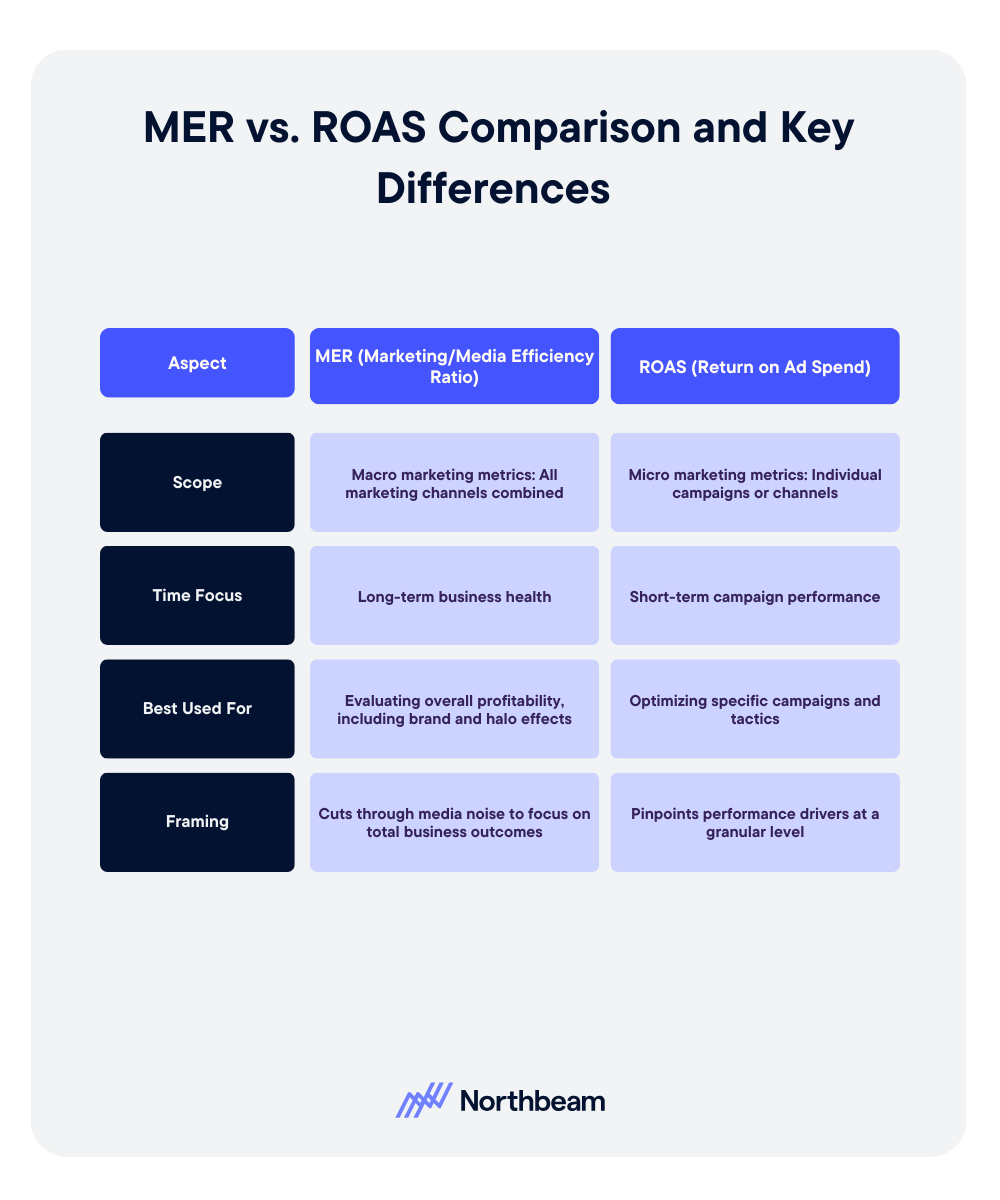
Why MER Matters Today
In an era of fragmented customer journeys and stricter privacy rules, attribution data is often incomplete. This is where MER shines.
Platform-reported ROAS can be misleading if it only counts conversions that can be directly tracked back to clicks or views.
For example, a customer who sees an Instagram ad, reads a blog post, and then purchases via an organic search might be invisible to that campaign’s ROAS — but MER captures the revenue regardless of the path taken.
As another example, imagine a DTC brand running paid search, paid social, and influencer partnerships saw an average ROAS of 2.0 in Meta Ads Manager.
However, when they calculated MER across all channels, the ratio was 3.5, revealing that paid social was driving halo effects in organic and email sales that platform metrics couldn’t see.
In omnichannel environments, where customers interact with multiple touchpoints before converting, MER becomes the true efficiency metric.
It sidesteps attribution gaps by focusing on actual business outcomes (total revenue vs. total marketing investment) giving marketing leaders the clarity they need to make strategic decisions.
When to Use MER vs. ROAS
Both MER and ROAS have their place. The key is knowing when to lean on each.

Let’s do a quick MER vs ROAS comparison:
Use MER when:
- Evaluating brand-wide health and overall profitability.
- Planning long-term budgets or proving ROI to stakeholders (e.g., CMO or board-level reporting)
- Measuring the combined impact of brand-building, organic growth, and paid media.
Use ROAS when:
- Optimizing the performance of an individual campaign or channel.
- Allocating budgets tactically across platforms based on near-term results.
- Testing creative, targeting, or bidding strategies for quick performance insights.
By pairing these metrics, you can make high-level strategic decisions while still fine-tuning the details that drive day-to-day performance.
Benchmarking MER & Best Practices
A good MER benchmark often falls around 5.0 or higher, meaning your business is generating $5 in revenue for every $1 spent on marketing.
However, good MER benchmarks can vary widely by industry, business model, and growth stage.
A scaling startup might operate with a lower MER in the short term, while a mature brand might aim for a higher ratio to sustain profitability.
Here are three best practices for using and improving MER effectively:
Standardize Your Inputs
Clearly define which revenue streams (e.g., online sales, retail, wholesale) and marketing costs (e.g., ad spend, agency fees, creative production) are included in your MER calculation.
Inconsistent definitions can distort trends and make it difficult to compare performance over time.
By keeping the inputs uniform, you ensure your MER is a true reflection of changes in efficiency, not changes in how you’re counting.
Track Continuously
Treat MER as a rolling benchmark, reviewing it monthly or quarterly rather than just at year-end.
This allows you to see the impact of campaigns, seasonal shifts, or budget adjustments in near real time.
Consistent tracking makes it easier to spot early warning signs or capitalize quickly on positive trends.
Pair MER with ROAS
MER delivers the big-picture view of how all marketing is working together, while ROAS zooms in on individual campaigns.
Using both ensures you can make strategic, company-wide decisions without losing sight of tactical optimizations.
This dual approach helps you balance long-term growth goals with short-term performance wins.
When applied consistently, MER becomes more than just a number: it’s a dependable signal for whether your overall marketing strategy is driving sustainable business outcomes.
MER and ROAS: The Full Picture
MER and ROAS aren’t competing metrics, they’re complementary tools.
MER gives you macro marketing metrics for overall marketing efficiency, showing how every channel works together to drive revenue.
ROAS delivers the micro-level insights you need to fine-tune specific campaigns and tactics.
The question is: Are your metrics driving clarity or creating blind spots?
By tracking both MER and ROAS, you can make confident decisions that support short-term wins and long-term growth.

Follow us














.svg)
